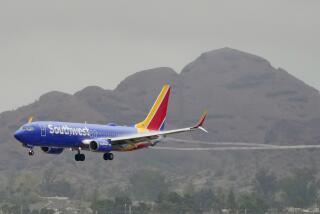Airlines End Some Discounts
The announcement made front-page news. In early November, Continental Airlines, a low-ticket-price innovator, shocked travelers.
Continental announced that it was eliminating discount fares in the three- to seven-day advance purchase category on most of its routes. The move was quickly matched by major airlines.
Most fares soared, more restrictions were added and leisure travelers began to panic quietly at the price increases.
Fares between New York City and Los Angeles went from $362 to $495, and cheap tickets zoomed to $362 on the Chicago-Dallas run. A Boston-to-Miami flight went from $240 to $428. On average, a 35% rise in air fares was expected across the board.
“What we’re seeing,” said one American Airlines official, “is a return to retail in pricing airline tickets. It’s a more realistic pricing approach because even though Continental may claim it has lower operating costs, their decision reflects the fact that with Maxsaver fares, even they couldn’t generate a profit.
“It is a false assumption that if you discount air fares 20% you’ll get 20% more passengers.”
Front-Page News?
But was the effort to raise fares really front-page news or just the latest in a series of cyclical fare changes? And did the fares increase as much as everyone expected?
The answer can be found by investigating something called yield management. It is also called the dark science of the airline business--the sensitive, almost secretive process of determining air fares by season, month, day of the week, aircraft type, number of seats and specific routes.
The airline officials responsible for yield management “are like the CIA,” one top airline executive said. “They keep things very close to the vest and, like their fares, are apt to change their minds without notice.”
Indeed, the yield management specialists work from both long- and short-range passenger load projections. For example, the yield management gurus at United can tell you a year in advance how many people they expect to fly on Flight 47, their nonstop flight between Chicago and Honolulu. They also can tell you--give or take a few passengers--how many will fly on that same flight next week.
Based on those projections, airlines can control capacity; they can limit or expand the number of seats available at various fares.
Advance Projections
When you see an airline ad that cautions “seats are limited” at certain fares, those limits are determined by these projections. The “yield” is what the airline will profit from the sale of all seats on the aircraft.
If an airline is careful--or in many cases, simply lucky--in its yield management, then it will only sell more discount seats after it has locked in a profitable yield from first- and/or business-class seats.
Discount seats yield smaller and, in some cases, virtually little profit other than cash flow, so airlines have to watch these figures on a daily if not hourly basis.
They construct fare models and research price sensitivity levels--the fare at which certain fliers will not travel.
Traditionally, when one airline discounts seats on a certain route, competing carriers boldly announce that they will match the fares.
But what the major airlines don’t tell you is that while they have officially offered a matching fare, they are not matching the same number of seats offered at that fare. For example, if Continental is selling 60 seats per flight at a Maxsaver fare, TWA or American might only be selling 30 per flight to protect their yields.
Two summers ago a computer mix-up at Pan Am cost the airline dearly. While it flew all of its planes virtually full across the Atlantic Ocean, it had failed to adequately limit the discount tickets for those flights.
“Although the planes were full,” a Pan Am spokesman said, “our yields were lousy, and we lost money.”
Some airlines have gone out of business flying planes that were 100% full. While the income from seat sales was sufficient to provide the airline adequate cash flow during the short run, the airlines failed because they simply could not generate an operating profit.
“This is exactly what happened at Continental,” one observer said. “They found they could easily fill their planes at lower fares, but there was no upside. Then they looked at their projections for October through December.
“When they saw higher demand than normal, they realized it didn’t make sense to discount fares during this period. So they raised them by eliminating many of the discount fares.”
Other airlines soon followed.
But this doesn’t mean that discount fares have been eliminated. Remember, yield management depends on passenger load projections. And, as you read this, a few discount fares have begun to creep back.
Indeed, the fare picture is not as bleak as it looked just a few weeks ago. Passenger projections from mid-January through the end of March are looking lower than expected for most airlines.
What is known is that the publicity associated with the earlier fare increases succeeded in scaring some passengers away. And the airlines’ yield managers are moving to make adjustments.
High Round-Trip Fare
For example, if you had to leave tomorrow, or even three days from now, the cheapest round-trip coach fare between Los Angeles and Boston on American Airlines is a whopping $1,240. (It’s $946 if you fly on a connecting flight and not a nonstop.)
Similar fares are quoted at United, TWA and other major carriers. But a little comparison shopping can get you a fare of $710.50 on Braniff (the flight connects through Kansas City). That’s a more than $500 saving from American’s nonstop fare and $236 from American’s connecting flight fare.
And Continental, the airline that first announced the elimination of many Maxsaver fares, began offering “winter sale” tickets in early December, marketing one-way Maxsavers of $99 off-peak and $119 peak for travel from certain Northeast and Midwest cities to Arizona and California.
The fares, which required that tickets be bought by Dec. 16 for travel between Jan. 5 and Feb. 15, applied to flights leaving from Boston, Buffalo, Burlington, Vt., Cleveland, Newark, Rochester and Syracuse to destinations including Los Angeles, Burbank, Phoenix, Tucson and San Diego.
And, even if you missed the Dec. 16 deadline, don’t despair. In the cyclical nature of airline fares, there is every reason to expect that what went up just a few short weeks ago will come down again.
Be on the lookout for more fare cuts by other airlines starting after the first of the year.
More to Read
Sign up for The Wild
We’ll help you find the best places to hike, bike and run, as well as the perfect silent spots for meditation and yoga.
You may occasionally receive promotional content from the Los Angeles Times.






